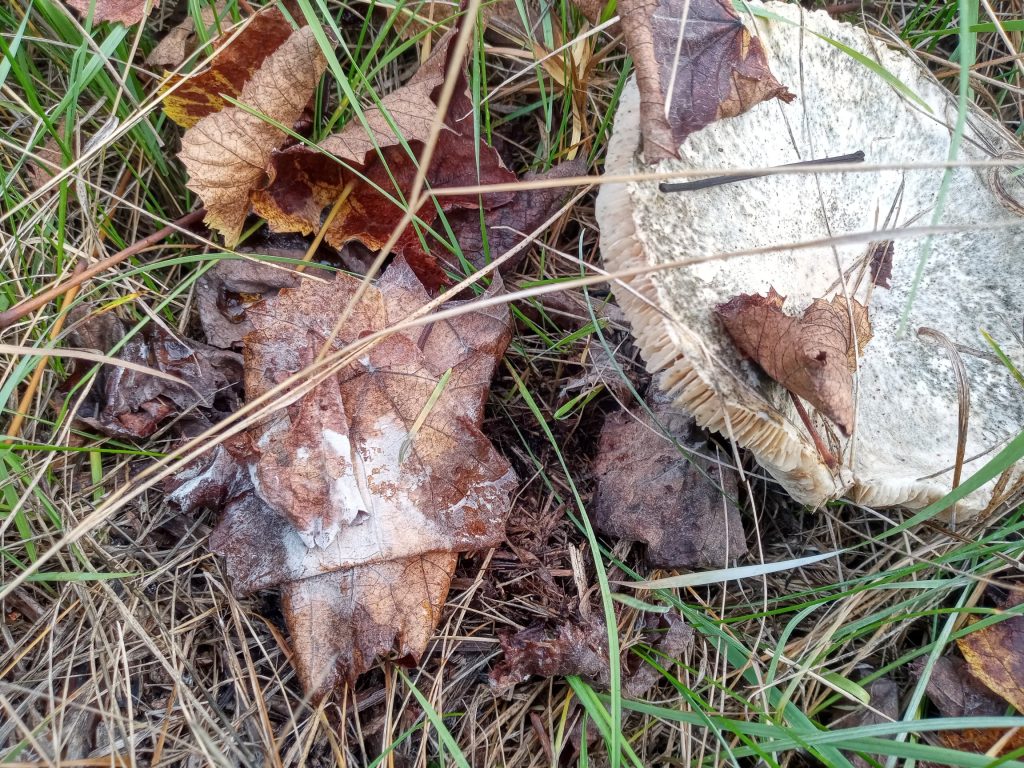Thirty-seven years ago, down here along the river (Lake Roosevelt) we could get a frost in the first or second week of September. An extended warm season reaching into October would have been called “Indian Summer”. As I am writing this near the end of October 2023, we still have not had temperatures below 40º. What we have had is rain, quite a bit of rain. This has spurred behavior not seen before in the vineyard. Plants that were virtually dried up with grape clusters hanging on bare branches have sprouted new leaves. Grass that was dry and mowed is now a foot high and green. I wouldn’t call this an ”Indian Summer”. I would call it a Second Spring.

Foremost in the renewed activity of this Fall has been the emergence of mushrooms, lots of mushrooms. The speed at which mushrooms grow has given us the term “mushroom growth”. It has given me pause to wonder what the heck is going on here. Having learned from soil testing that my biggest problem during the summer was water draining away too quickly in our sandy soil even though it was given water regularly. I was expecting to soon be spreading an assortment of soil amendments on some parched earth. I will still spread them, but they will be delivered into the waiting threads of millions of miles of mushroom mycelia.
That might seem like an exaggeration, but it is accurate. Paul Stamets explains in his comprehensive book, Mycelium Running, that each cubic inch of soil can contain 8 miles of mycelia, or over 50 million miles per acre. Mycelia are the tiny single cell threads that build the web of tissue from which mushrooms emerge. They are sensitive to pressure, temperature, moisture, and the microbiome in which they exist. So, walking through my vineyard I am triggering reactions from the matrix of mycelia from which all these mushrooms grow. I can get used to that but still want to know what they are doing to the vineyard.
We tend to think of mushrooms as related to rot, which indeed they are. And we tend to think that rot is a bad thing. That’s where it gets a little trickier. When humans eat anything rotten and many kinds of mushrooms, the results can go from bad to deadly. Truthfully, I was thrilled to see so many mushrooms in the vineyard because I know that mycorrhizal mushrooms form a symbiotic relationship with the roots of plants like grape vines which benefits both. The plant produces sugars which the fungi can’t produce themselves and the fungi bring water and minerals to the plants increasing the range of their root nourishment uptake many times over. Questions remained about how different fungi function and why the sudden proliferation of mushrooms.
Mushrooms are not individuals like plants springing out of the ground. They are basically the fruit and seeding body of the fungi, a lot like apples on a tree. The cool part is that when the mushrooms come up, they can tell what kind of fungi are growing in your ground.
The simple answer about why they are abundant now is moisture. Mushrooms reproduce with spores. Some can produce 30 billion spores each day. Unlike seeds, in a moist environment, mushroom spores are ready to sprout into hyphae, the fine, branching tubes which make up the body (or mycelium) of a multicellular fungus. With millions of them coming from a single mushroom, they soon join with each other to form a mat of mycelium. Walking through the vineyard, I found a mat of mycelium already growing on grape leaves beneath a rotting mushroom. The disintegrating mushroom body is fertilizer for the next generation. That mat of mycelium will work its way into the soil within days.

White mycelium growing on leaves
As a grape grower I was hoping to find mycorrhizal mushrooms, the kind that form beneficial bonds with plant roots. The first two pictures in the composite photo are boletes also known as porchini. They are sometimes edible. This variety is called a Slippery Jack. The top is slimy. Once bonded with the roots of plants, they bring them water and minerals. They can also help fight disease and foster growth in young plants. Truffles and chantarelles are also mycorrhizal. Truffles like oaks and chantarelles like fir trees. Boletes are associated with pine trees. I am not sure if any of them bond well with grapes.
Another category of mushrooms is endophytic. They are less common to identify because they can live within the plant itself and spread without spores. They can increase “acquisition of nutrients and the amount of phytohormones in the plant, which is directly related to the increase in biomass production, expansion of root system development, plant height, weight reproduction and yield.” (nih.gov) Stamets describes a case where wood chips were layered in gardens. Psilocybin mushrooms grew in those chips even though there were no previous occurrences nearby and they are normally associated with cow pies. They had to have lived in the chips themselves. Endophytes have also been shown to increase biodefence from pathogens. I have not seen any psilocybin in the vineyard. But I have the app now. You never know…
